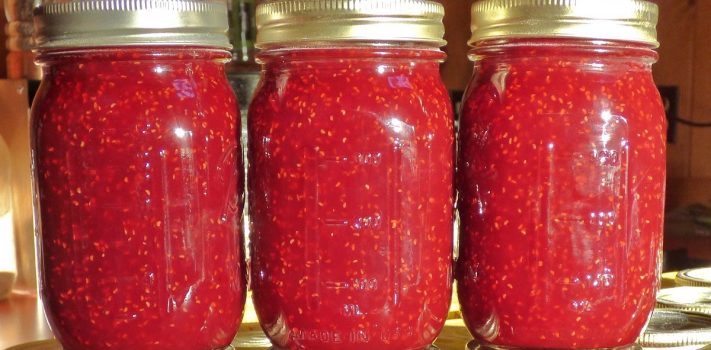One of the entertaining but frustrating things about the internet is how much incorrect info is out there, and how often that same wrong information gets recycled on hundreds of web sites, often verbatim.
So, let’s put one of them to rest once and for all: reusing canning lids.
It would never cross your mind to do an internet search, “Do peaches taste better when they’re hard or after they soften up?” Obviously, it’s very simple to test it yourself by trying one of each and drawing your own conclusions instead of relying on the opinions of others. The same is true of reusing canning lids.
POPULAR NOTIONS ABOUT REUSING CANNING LIDS
When it comes to reusing canning jar lids, I’ve read everything from “absolutely, in a million years, not,” to “I’ve tried reusing them but only half of them sealed.”
Here are some of the more common reasons people give for not reusing canning lids:
• The Ball website and many ag extension offices say they should never be reused.
• They may not seal and the batch will be ruined after all my hard work.
• I reuse them but only one per batch in case it doesn’t seal.
• I’m afraid to use them because someone told me not to.
• Are you kidding? You’ll get botulism.
Needless to say, there are many opinions on the subject. So, I’m going to share my personal experience with you but please, don’t take my word for it! You can easily test it for yourself and then speak authoritatively the next time you hear the question asked.
The COVID conundrum has caused a shortage of canning supplies, the likes of which most of us have never seen, and prices have skyrocketed. Canning lids used to be in the neighborhood of $2.00. I’ve checked weekly over the past year just out of curiosity and the only lids I’ve seen since March of 2020 were in April of 2021 at $3.99/dozen. Many folks are wondering how they’re going to get their canning accomplished this year if lids are unavailable. More than ever, people are asking if canning lids can be reused.
An even crazier question is whether jars and lids from things like store-bought salsa, pickle, and pasta sauce can be cleaned up and reused for canning.
To both of these questions, I say without reservation, yes! Both canning lids and one-piece lids from various products can be reused time and time again.
LET’S DO A TEST
We all wonder about many things in life, most of which we lack the means to test for ourselves. Fortunately, canning jar lids don’t fall into that category and anyone who does home canning is able to carry out this simple test.
We’re going to can some good old H2O so this experiment won’t cost anything and you’ll end up with some jars of water for storage. You can do this experiment using your regular canner or you can take a shortcut and use your microwave. If using your canner, do everything exactly as you would if you were canning peaches or tomatoes, especially the lid preparation in hot water.
If you’re using a microwave, prepare the lids and rings just as you would for any canning project. Fill a small saucepan with water, put the lids and rings in, bring to a boil, and then shut the heat off. Inspect the lids beforehand making sure there are no warps or dings, all the sealant is in place, and there’s no rust or corrosion. The jar rims should be smooth with no blemishes.
Next, fill some jars with water to within ¾” of the top and microwave each one until the water is boiling or nearly so. Once the water is very hot remove the jars from the microwave, then do one of the most important steps in canning: wipe the rim of the jar to be sure it is absolutely clean with no foreign matter. The vast majority of jars that don’t seal properly are due to the rim not being clean, not to canning lid failure.
Once you’ve wiped the rim clean, remove a canning lid from the pan of hot water and place it on the jar, then screw it down finger tight as you would if you were canning pickles or peaches. Before long you’ll hear the lids popping as they seal and if you’ve canned your water properly, the seal will hold indefinitely.
WHY USED LIDS RESEAL
Technology has come a long way since the days of canning with zinc caps and porcelain lids using a rubber gasket. Even after the invention of today’s lids, technology has continued to improve the sealant used on the lid. I’ve seen old lids at auctions that used a sealant which was very different from what I see today and I would not consider using those lids for my canning. Today’s lids have a different type of sealant that can be re-softened for repeated uses.
In Photo 3 you’ll see three lids. The first is brand new, taken from a case of new jars. The second lid is from a jar containing some of last year’s produce, and the third lid shows the sealant from a used lid after it was heated in water in preparation for today’s canning project
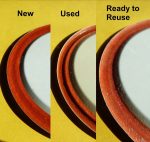 Notice the new lid has a slight indentation all around the rim from where it was contacting the jar when it was removed from the case. On the used lid, the indentation is very deep from having been heated, then placed on a jar full of produce and screwed down tight to form a seal. The third lid, a used one, has just come out of the saucepan of hot water ready to use on a canning jar. Notice it has even less indentation than the new lid as it came out of the case. During the heating process, the sealant softens and returns to its original shape, ready to seal another jar as efficiently as it did the last time around. When this recycled lid is used for canning, it will perform as well as a brand-new lid.
Notice the new lid has a slight indentation all around the rim from where it was contacting the jar when it was removed from the case. On the used lid, the indentation is very deep from having been heated, then placed on a jar full of produce and screwed down tight to form a seal. The third lid, a used one, has just come out of the saucepan of hot water ready to use on a canning jar. Notice it has even less indentation than the new lid as it came out of the case. During the heating process, the sealant softens and returns to its original shape, ready to seal another jar as efficiently as it did the last time around. When this recycled lid is used for canning, it will perform as well as a brand-new lid.
It’s just that simple. Do the test yourself and all your doubts about whether used lids will seal or not will be erased. The most important steps are 1.) be sure the lids are brought to a boil and then the heat turned off, and 2.) the jar rim is wiped absolutely clean. Do these two things and you’ll have a near-perfect lid seal record.
WHY REUSE CANNING JAR LIDS?
You can buy jars today for $10 at some of the big stores, which comes to 83¢ each. The big canning-jar companies are happy to give you a good price on the jars because at $3.99 for a box of 12 lids, you’ll be spending $40 over the next ten years buying new lids for those same 12 jars. It’s no wonder why canning jar companies tell us not to reuse lids. If you’re a serious canner who does 100 jars per year, you’re looking at spending $333 on new lids over the next ten years. And many of us use far more than 100 jars per year.
The economics alone was enough incentive for me to try reusing canning lids. In all the years I’ve been reusing lids, I only rarely have one that fails to seal and most years none fail. Brand-new lids have the same failure rate. Once I discovered how imperative it is to get the jar rim perfectly clean, tipping my head to see the light reflecting just to be sure, my jars only rarely fail to seal.
In addition to the cost savings of reusing lids, they store in a very small area. In Photo 2, you can see that 66 used lids fit into one 15 oz vegetable can. Even if you decide not to reuse your lids, it’s a good idea to save them since they take up so little room. You never know what the future will bring and two dozen is one and one dozen is none as many found out in 2020.
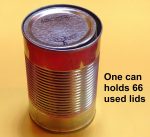 Another thing I do to make reusing lids easier is to write a small code letter near the edge of the lid instead of writing out a description of what’s in the jar. I can see that it’s three-bean salad, raspberry jam, potatoes, or tomato sauce, so there’s no need to write it out. All I need to know is the year it was canned so I write a small letter for the year: A = year ending with 1 (2021), B for 2022, J for 2030, etc. It’s much easier to remove than a long name if the need arises.
Another thing I do to make reusing lids easier is to write a small code letter near the edge of the lid instead of writing out a description of what’s in the jar. I can see that it’s three-bean salad, raspberry jam, potatoes, or tomato sauce, so there’s no need to write it out. All I need to know is the year it was canned so I write a small letter for the year: A = year ending with 1 (2021), B for 2022, J for 2030, etc. It’s much easier to remove than a long name if the need arises.
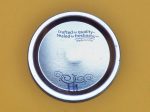 One last word on reusing canning lids. Some websites warn that reusing canning lids is “unsafe.” That’s simply not true. The lids either work or they don’t work and there’s no middle ground. You’re either dead or alive, the Cubs either won or lost, and the lids either sealed or they didn’t. The same rule applies whether you’re using brand-new lids or recycling used lids for the 17th time: if the button on the lid is down after the jars cool, the contents are safe. If the button is up, the contents are safe as long as the jar is put into the refrigerator to be used first. If only the rest of life were that simple!
One last word on reusing canning lids. Some websites warn that reusing canning lids is “unsafe.” That’s simply not true. The lids either work or they don’t work and there’s no middle ground. You’re either dead or alive, the Cubs either won or lost, and the lids either sealed or they didn’t. The same rule applies whether you’re using brand-new lids or recycling used lids for the 17th time: if the button on the lid is down after the jars cool, the contents are safe. If the button is up, the contents are safe as long as the jar is put into the refrigerator to be used first. If only the rest of life were that simple!
REUSING SALSA, PICKLE, AND PASTA SAUCE JARS
I’ve always been into recycling and repurposing things I buy and jars are no exception. So naturally the question arose, “Can I reuse all those salsa, pickle, and pasta sauce jars and their lids?”
 As with Mason jars, this is super simple to test for yourself using the same method outlined above. In Photo 4, the lid on the left is from a pasta sauce jar, shown here after washing. The second lid was put through the normal canning lid preparation process in a saucepan of hot water. Though not quite as visible as in the Mason jar lids, you can still see the groove just outside of the orange ring in the used lid and the same ring absent in the lid on the right with the reconstituted sealant. You can see the finished experiment in Photo 5 showing the canned water next to one of the jars of pasta sauce they came from, taken at an angle to show that all the lids have sealed.
As with Mason jars, this is super simple to test for yourself using the same method outlined above. In Photo 4, the lid on the left is from a pasta sauce jar, shown here after washing. The second lid was put through the normal canning lid preparation process in a saucepan of hot water. Though not quite as visible as in the Mason jar lids, you can still see the groove just outside of the orange ring in the used lid and the same ring absent in the lid on the right with the reconstituted sealant. You can see the finished experiment in Photo 5 showing the canned water next to one of the jars of pasta sauce they came from, taken at an angle to show that all the lids have sealed.
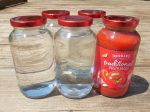 Reusing jars from various store-bought products is not only safe and economical, but is the cheapest way to buy jars that I know of. I currently buy pasta sauce at Aldi for 85¢ per jar, or $10.20 per case of 12. The way I look at it, I’m getting a case of pint-and-a-half jars for $10 just like the big stores charge, plus for 20¢ more, I’m getting 2¼ gallons of pasta sauce. That’s less than 10¢ per gallon for pasta sauce. I’ll take that deal any day of the week. Even if you don’t like pasta sauce and there are no jars available anywhere, you can dump all the pasta sauce into the compost pile (may your Italian ancestors forgive you!) and have yourself 12 pint-and-a-half jars and lids.
Reusing jars from various store-bought products is not only safe and economical, but is the cheapest way to buy jars that I know of. I currently buy pasta sauce at Aldi for 85¢ per jar, or $10.20 per case of 12. The way I look at it, I’m getting a case of pint-and-a-half jars for $10 just like the big stores charge, plus for 20¢ more, I’m getting 2¼ gallons of pasta sauce. That’s less than 10¢ per gallon for pasta sauce. I’ll take that deal any day of the week. Even if you don’t like pasta sauce and there are no jars available anywhere, you can dump all the pasta sauce into the compost pile (may your Italian ancestors forgive you!) and have yourself 12 pint-and-a-half jars and lids.
Pasta sauce has many uses and at 85¢ per jar, that’s the same price or cheaper than a 28-ounce can (by weight) of tomato sauce, and both the can and the pasta sauce jar contain a pint and a half by volume. It makes great chili and for the most part the Italian spices are overrun by the chili spices, especially if you use half pasta sauce and half tomato sauce.
I also use it as a base for my spaghetti sauce, adding a lot of other ingredients and spices. Aside from spaghetti, I enjoy my beefed-up pasta sauce on omelets, and heated up by itself it’s better than any tomato soup, IMO. There are lots of options for pasta sauce besides pasta.
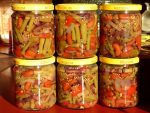 How many times will these jars seal? If the salsa jars I make yogurt in are any indication, they should keep sealing for the next 25+ years. I use 10 one-pint salsa jars for making yogurt, five for each batch. I keep track of how many batches I’ve made by writing “Batches 97-128” on the outside of the box of 32 quarter-ounce packets of gelatin I use. I’m currently on batch number 104, meaning each set of jars has been reused 52 times. The lids have sealed every time and look like they’ll do at least 52 batches more.
How many times will these jars seal? If the salsa jars I make yogurt in are any indication, they should keep sealing for the next 25+ years. I use 10 one-pint salsa jars for making yogurt, five for each batch. I keep track of how many batches I’ve made by writing “Batches 97-128” on the outside of the box of 32 quarter-ounce packets of gelatin I use. I’m currently on batch number 104, meaning each set of jars has been reused 52 times. The lids have sealed every time and look like they’ll do at least 52 batches more.
I use the same kind of salsa jars to can my pickled three-bean salad and they’ve sealed 8-10 times now without a single failure.
 The last type of jars I recycle are one-pint bread and butter pickle jars (Photo 7) which I use for my own bread and butter pickles. They’re the same diameter as Ball/Kerr pint jars so they fit neatly into the wooden canning-jar crates I use. I can also tell at a quick glance which jars the pickles are in. I’ve only recently started asking friends to save me their “specialty” jars which jam, honey, and other items come in. It may take a while but once I get enough of each style, I’ll use them to make three-packs of my honey, blackberry jam, and raspberry jam to give as gifts.
The last type of jars I recycle are one-pint bread and butter pickle jars (Photo 7) which I use for my own bread and butter pickles. They’re the same diameter as Ball/Kerr pint jars so they fit neatly into the wooden canning-jar crates I use. I can also tell at a quick glance which jars the pickles are in. I’ve only recently started asking friends to save me their “specialty” jars which jam, honey, and other items come in. It may take a while but once I get enough of each style, I’ll use them to make three-packs of my honey, blackberry jam, and raspberry jam to give as gifts.
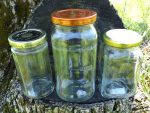 One final comment about reusing “non-canning” jars. I’ve heard some say that the jars aren’t as sturdy as canning jars and will break in the canner. Back in the olden days when people recycled quart mayonnaise jars, that may have been the case. I got my micrometer out so I could break some jars to measure wall thickness…but couldn’t bring myself to break the jars! I can say however, the jars feel as heavy and thick as Mason jars and all the jars I’ve used including pickle, salsa, and pasta sauce jars, have held up for years without a single one breaking in the canner.
One final comment about reusing “non-canning” jars. I’ve heard some say that the jars aren’t as sturdy as canning jars and will break in the canner. Back in the olden days when people recycled quart mayonnaise jars, that may have been the case. I got my micrometer out so I could break some jars to measure wall thickness…but couldn’t bring myself to break the jars! I can say however, the jars feel as heavy and thick as Mason jars and all the jars I’ve used including pickle, salsa, and pasta sauce jars, have held up for years without a single one breaking in the canner.
CONCLUSION
In closing, let me quote from FDR’s inaugural address, March 4, 1933:
“So, first of all, let me assert my firm belief that the only thing we have to fear is fear itself – nameless, unreasoning, unjustified terror which paralyzes needed efforts to convert retreat into advance.”
All too often our fears are “nameless” and “unreasoning” and we have “unjustified terror” of things we shouldn’t, things we can easily test for ourselves instead of listening to inexperienced fear mongers who are passing on what they’ve heard instead of what they’ve experienced. Don’t be one of them. Perform this simple test and answer for yourself, once and for all, whether canning lids and salsa jars can be reused.
Then start saving your used lids and jars. They’ll make great barter items after the SHTF as well, especially when you can speak authoritatively that you’ve been doing it for years with great success.
—
JWR Adds: I’m sure that this article will be controversial–both amongst SurvivalBlog readership, and within individual families. One way to avoid any of the latter is to stock up on Harvest Guard reusable lids, rather than “one use” disposable lids. They cost more at the outset, but they are proven to be safely usable for many dozens of times.

